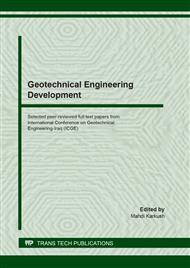p.228
p.234
p.243
p.253
p.259
p.266
p.273
p.283
p.292
Investigation to some Preliminary Geotechnical Properties of Soft Clay Stabilized by Fly Ash Based Geopolymers
Abstract:
The civil engineering projects that includes soft clay within its activities has a serious concern of hazards, such hazards can be overcame by treating the existing soils by certain materials which are named as "stabilizers". The common materials that are highly used in this field are ordinary Portland cement, fly ash, lime and rice husk ash, etc. Each one of these stabilizers has its known shortcomings. The alkali activation of any alumina silicate source produces some kind of cost effective primary binding gel which is known as "Geopolymers". This study is devoted to investigate the role of liquid over fly ash ratio to some soil – FA based Geopolymers geotechnical properties. Such ratio is taken as 2.71, 3.167, 3.8 and 4.75 respectively within the experimental program and the investigated geotechnical properties are the specific gravity, liquid and plastic limit, compaction characteristics and California bearing ratio. The tests results showed that the maximum dry density decreased about 42 % at 2.71 liq/FA whereas this the specific gravity decreased 27 % at the same this ratio. In addition, the 3.8 and 4.75 of such limits revealed no plastic behavior due to the high presence of liquid.
Info:
Periodical:
Pages:
259-265
Citation:
Online since:
August 2020
Authors:
Price:
Сopyright:
© 2020 Trans Tech Publications Ltd. All Rights Reserved
Share:
Citation:


